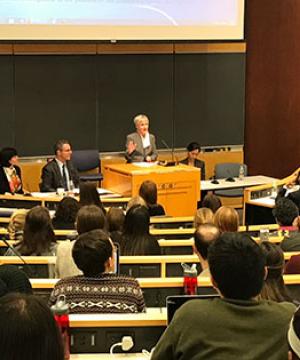Judge Denise Cote ’75 Counsels Students on Managing Complexity in Cases
U.S. District Judge Denise Cote ’75, who adjudicated the largest set of lawsuits to arise from the 2008 financial crisis, visited Columbia Law School recently to talk with students about managing complex cases and minimizing adversarial exchanges between opposing counsel.
The lesson came in a look back by Cote at how she handled a suite of 16 lawsuits filed in 2011 in Manhattan by the Federal Housing Finance Administration (FHFA). The federal agency accused several Wall Street banks of misrepresentations in the sale of bonds that sparked a financial meltdown and forced the U.S. Government to rescue the housing market.
Named to the bench in 1994 after having been the first woman to lead the criminal division of the U.S. Attorney’s Office in Manhattan, Cote has earned a reputation for hard work, meticulousness, and clarity.
“The complaints all pursued the same theory, which is that this strict-liability statute had been violated,” Cote told the overflow crowd of about 100 students and faculty, referring to Section 11 of the Securities Act of 1933. “The parties had a schedule that was uniform across the cases and knew when they would go to trial.”
Interestingly, Cote was joined in the discussion by Susanna Buergel ’99, a partner at the law firm Paul Weiss who represented Citigroup in the lawsuit; Brad Karp, the chair of Paul Weiss; and Manisha Sheth, who represented FHFA and who is now New York’s executive deputy attorney general for economic justice. Columbia Law Professor Bert Huang moderated.
The lawyers all credited Cote for keeping the litigation on track. The limit on the length of filings over discovery disputes “was an important factor for us; it forced us to bring the most critical points to your attention,” Buergel told her. “In this courtroom, there was a discipline.”
“The two-page limit expedited the process,” added Sheth.
Promoting dialogue
A year into the litigation, Superstorm Sandy struck the city, knocking out power and paralyzing public transportation. “I had no power, the lights were out in lower Manhattan, and I was biking to work,” Buergel recalled. “Manisha was phenomenal and lovely and very forgiving. It was a constant dialogue.”
“That’s a wonderful comment about the law,” said Cote. “There can be a lot of tension and conflict, but it’s not necessarily the way you need to behave to be a successful lawyer.”
Cote knows something about success. As a law student, Cote, who also holds a master’s degree in history from Columbia, served as a Notes & Comment Editor of the Columbia Law Review and graduated near the top of her class.
After law school, she clerked for Judge Jack B. Weinstein ’48 of the U.S. District Court in Brooklyn. Weinstein, who at 96 continues to serve as a jurist, is advocating for female lawyers to play a more significant role in court proceedings.
From the bench, Cote has presided over disputes that stand out for their complexity. In 2013, she ruled that Apple conspired with publishers to raise the price of e-books in violation of antitrust laws.
A decade earlier, she adjudicated a series of 42 class actions and over 100 individual actions charging banks that issued securities on behalf of WorldCom – once the nation’s second-largest telecommunications company – with violations of securities laws that led to settlements of over $6 billion.
Most recently, in September, the U.S. Court of Appeals for the Second Circuit affirmed her 361-page ruling in favor of FHFA in the 16th action – against Nomura Holdings – following a trial. By then, 15 of the banks sued by FHFA had settled, resulting in more than $20 billion in recoveries.
Related reading
Deconstructing the Financial Crisis
###
Posted on Nov. 29, 2017
